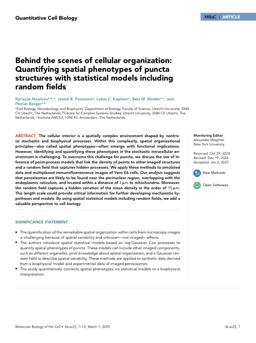2025-03-01
Behind the scenes of cellular organization: Quantifying spatial phenotypes of puncta structures with statistical models including random fields
Publication
Publication
Mol. Biol. Cell , Volume 36 - Issue 3 p. ar22: 1- 12
The cellular interior is a spatially complex environment shaped by nontrivial stochastic and biophysical processes. Within this complexity, spatial organizational principles—also called spatial phenotypes—often emerge with functional implications. However, identifying and quantifying these phenotypes in the stochastic intracellular environment is challenging. To overcome this challenge for puncta, we discuss the use of inference of point-process models that link the density of points to other imaged structures and a random field that captures hidden processes. We apply these methods to simulated data and multiplexed immunofluorescence images of Vero E6 cells. Our analysis suggests that peroxisomes are likely to be found near the perinuclear region, overlapping with the endoplasmic reticulum, and located within a distance of 1 μm to mitochondria. Moreover, the random field captures a hidden variation of the mean density in the order of 15 μm. This length scale could provide critical information for further developing mechanistic hypotheses and models. By using spatial statistical models including random fields, we add a valuable perspective to cell biology.
| Additional Metadata | |
|---|---|
| American Society for Cell Biology | |
| doi.org/10.1091/mbc.E24-10-0461 | |
| Mol. Biol. Cell | |
| Organisation | Theory of Biomolecular Matter |
|
Nicolaou, K., Passmore, J., Kapitein, L., Mulder, B., & Berger, F. (2025). Behind the scenes of cellular organization: Quantifying spatial phenotypes of puncta structures with statistical models including random fields. Mol. Biol. Cell, 36(3), ar22: 1–12. doi:10.1091/mbc.E24-10-0461 |
|
